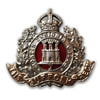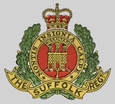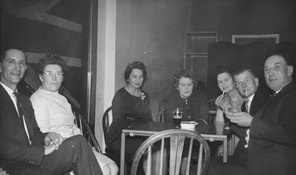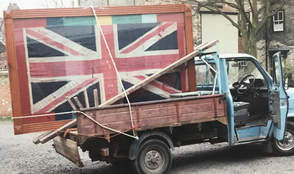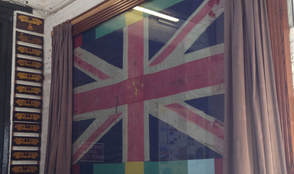The Leiston Branch
of The Friends of The Suffolk Regiment
The Leiston F.E.P.o.W. Memorial
The Leiston Branch of the Suffolk Regiment Old Comrades Association are the custodians of an important and sacred piece of Suffolk Regiment history. A large Union flag that was kept by the 4th Battalion through their three and a half years of Japanese captivity.
The flag was used at the funeral of every Suffolk soldier who died in Chunkai camp and was draped across the altar of the little chapel built by the prisoners. it symbolised the very freedom that they had fought for and was a symbol of hope in those dark days. After the war it was brought home and kept as a memorial to those of the town and of the Leiston Company who did not return.
Below is a brief history of the memorial, its move from the TA Centre to the Long Shop museum, and it future in the soon to be revamped, museum.
The flag was used at the funeral of every Suffolk soldier who died in Chunkai camp and was draped across the altar of the little chapel built by the prisoners. it symbolised the very freedom that they had fought for and was a symbol of hope in those dark days. After the war it was brought home and kept as a memorial to those of the town and of the Leiston Company who did not return.
Below is a brief history of the memorial, its move from the TA Centre to the Long Shop museum, and it future in the soon to be revamped, museum.
The Memorial FlagThe flag at the TA Centre in the 1960s
Image courtesy Jim Taylor |
At the Long Shop Museum in Leiston there hangs framed, a large and rather battered Union Flag with special significance to the men of the 4th Battalion.
This flag was draped across the altar of the small bamboo church erected by the prisoners when they were held in Chunkai prisoner of war camp in Thailand from 1943 until 1945. The flag was used for all burials in the camp and when the Japanese capitulated in August 1945, the flag was hoisted from the camp flag pole in celebration. In 1945, Corporal Bailey, a member of the 4th Battalion form Leiston, brought the flag home and had it framed to preserve it as a permanent memorial to all those of the Battalion who died in captivity. Originally from 1961 onwards, it was housed in the newly-built Drill Hall and Cadet Centre, and was a focal point in the Main Hall. Standing in a frame measuring 11 ft. by 6 ft. the timbers were salvaged from Southwold Pier and the frame made in the pattern shop of the local Garrett’s Engineering Works. The background of the frame contained the colours of the ribbon for the Pacific Star; a medal that all Far East Prisoner of War were awarded. Time moved on and in 1992, C.S.M. Arthur “Smudger” Smith, worried that the town now only had a Cadet presence (since the T.A. detachment had been disbanded) thought that the flag should be moved from the Cadet Centre to a more publically accessible location where it could be viewed by many more people. |
A Move To The Long ShopThe flag en-route to the Long Shop
Image courtesy Jim Taylor |
Smudger had hoped that the Regimental Museum would take the memorial, but they politely declined due to it being impossible to get it up the stairs into the Museum. However branch member, Ray Saxby proposed approaching the town’s Long Shop Museum, less than 500 yards away, to see if they would be prepared to accept such an important memorial to the town’s servicemen.
The Long Shop Museum, which told the story of the Garrett’s Engineering Works, agreed after consultation with its Trustees, to accept the flag on permanent loan for display. The Regimental Newsletter from January 1993 noted that “there can be no doubt that we owe our Branch President (John Perrett) who is also the Hon Secretary and a Trustee of the Museum, a great debt in persuading the trustees to take this step”. After two days hard work by “Toddy” Stebbings and John Bye, within two hours the flag had been carefully transported from the Cadet Centre to the Museum, and the following day, the team reassembled to hoist the flag up into position on the wall in the Museum. Smudger later wrote “Naturally, the Branch are very proud to have achieved their object of ensuring this important Memorial Flag to a position where it can be more readily seen by a much wider public”. A unique memorial to the men of the town who suffered at the hands of their Japanese captors, it was noted that “The Branch is very conscious that it is dedicated to ALL those who suffered and died during those three years of living hell as Far East Prisoner of War and hopes that any FEPOW who happens to be in the Leiston are will make a special effort to visit the museum” |
The FutureThe flag on display at the Long Shop Museum
Image courtesy Mark Forsdike |
Recently, the Museum has been fortunate enough to secure a sizeable Heritage Lottery Grant to redevelop and update many areas of their displays. Discussions early on suggested that there may not be a home for the Memorial Flag in the newly redesigned museum, but in recent weeks, we have seen a letter stating that “The latest position re: the flag is that it is likely to be put back in its current case, in its current location, after the Transformation Project building work is completed”.
This is promising news for the Memorial Flag, which is listed on the National Inventory of War Memorials, as it is the only known War Memorial which takes the form of an object from the period it commemorates, rather than a specially constructed monument or tablet erected afterwards. The architects plans upon which the funding was given, states that “the flag is intended to be retained in its existing position with the addition of a roller blind to cover the flag in the uncontrolled lighting conditions. The surface of the blind could also be used as a projection surface”. We hope that this unique memorial will continue to be part of the fabric and history of the town and will remain on public display as was intended by those who sought to move it to the Long Shop. We shall keep you updated as to the progress of their project. |
